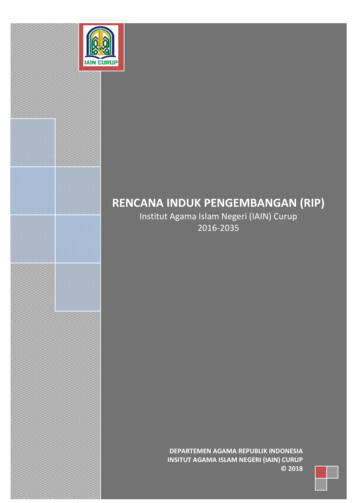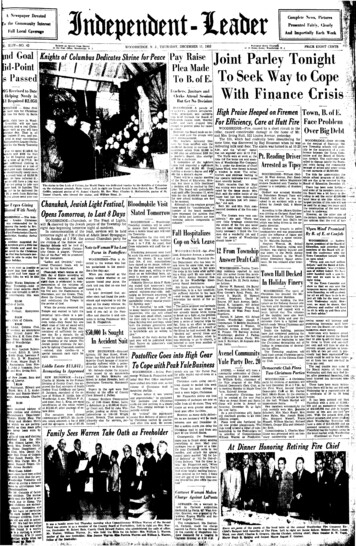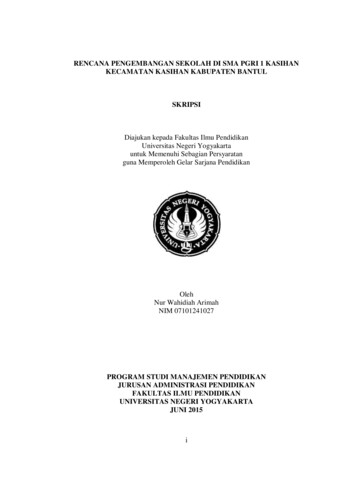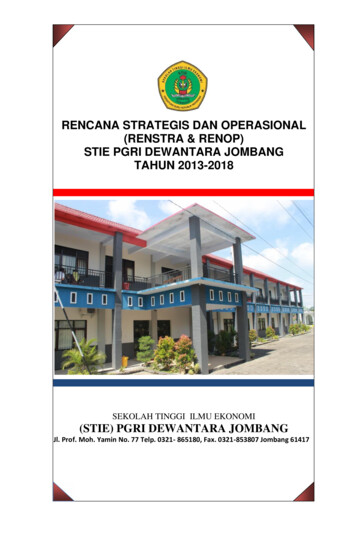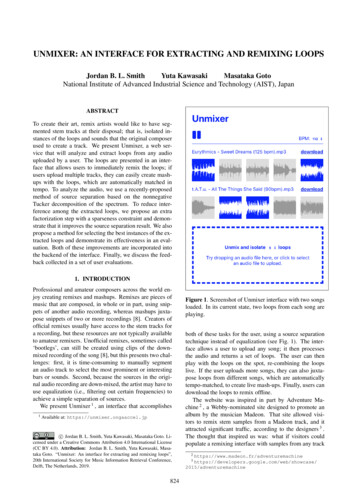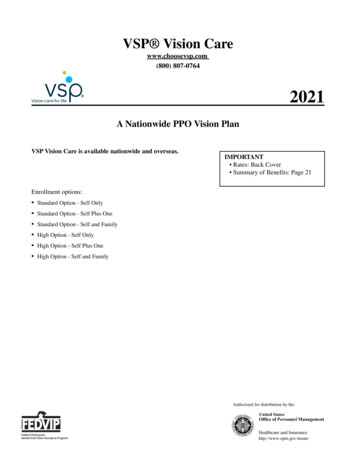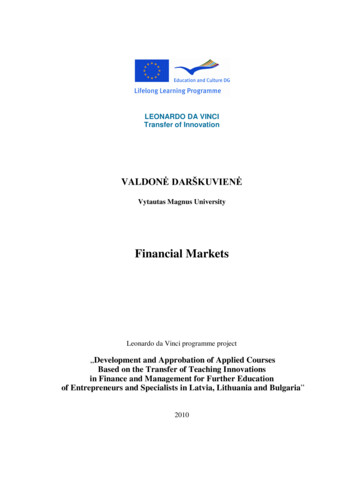
Transcription
LEONARDO DA VINCITransfer of InnovationVALDONĖ DARŠKUVIENĖVytautas Magnus UniversityFinancial MarketsLeonardo da Vinci programme project„Development and Approbation of Applied CoursesBased on the Transfer of Teaching Innovationsin Finance and Management for Further Educationof Entrepreneurs and Specialists in Latvia, Lithuania and Bulgaria”2010
TABLE OF CONTENTSTable of contents. 2Introduction . 51. FINANCIAL MARKETS: STRUCTURE AND ROLE IN THE FINANCIALSYSTEM . 61.1. Financial system structure and functions. 61.2. Financial markets and their economic functions. 71.3. Financial intermediaries and their functions . 91.4. Financial markets structure . 111.4.1.Financial instruments . 111.4.2.Classification of financial markets . 131.5. Financial market regulation . 141.6. Summary . 15Key terms. 15Further readings . 16Review questions and problems . 162. INTEREST RATES DETERMINATION AND STRUCTURE . 172.1. Interest rate determination . 172.1.1.The rate of interest . 172.1.2.Interest rate theories: loanable funds theory . 192.1.3.Interest rate theories: liquidity preference theory. 202.2. The structure of interest rates. 202.3. Term structure of interest rates. 222.4. Theories of term structure of interest rates . 222.4.1.Expectations theory. 232.4.2.Liquidity premium theory . 252.4.3.Market segmentation theory. 262.4.4.The preferred habitat theory . 262.5. Forward interest rates and yield curve. 262.6. Summary . 29Key terms. 29Further readings . 30Relevant websites. 30Review questions and problems . 303. MONEY MARKETS . 333.1. Money market purpose and structure . 333.1.1.The role of money markets. 333.1.2.Money market segments . 343.1.3.Money market participants. 363.2. Money market instruments . 373.2.1.Treasury bills and other government securities. 373.2.2.The interbank market loans . 423.2.3.Commercial papers . 433.2.4.Certificates of deposit . 453.2.5.Repurchase agreements. 463.2.6.International money market securities . 493.3. Money market interest rates and yields . 513.4. Summary . 54Key terms. 542
Further readings . 54Relevant websites. 55Review questions and problems . 554. DEBT MARKETS . 574.1. Debt market instrument characteristics . 574.2. Bond market . 594.2.1.Bond market characteristics . 594.2.2.Bond market yields . 604.3. Bond valuation . 614.3.1.Discounted models. 614.3.2.Bond duration and risk. 634.3.3.Bond price volatility . 634.3.4.Behavior of Macaulay’s duration . 654.3.5.Immunization. 654.3.6.Bond convexity. 654.4. Bond analysis . 674.4.1.Inverse floaters and floating rate notes . 674.4.2.Callable bonds . 674.4.3.Convertible bonds . 694.5. Summary . 70Key terms. 71Further readings . 71Review questions and problems . 715. EQUITY MARKET . 735.1. Equity instruments. 745.1.1.Common shares . 745.1.2.Preferred shares . 755.1.3.Private equity. 775.1.4.Global shares and American Depository Receipts (ADR). 785.2. Primary equity market . 805.2.1.Primary public market. 805.3. Secondary equity market . 835.3.1.Organized exchanges . 845.3.2.Over-the-counter (OTC) market . 865.3.3.Electronic stock markets . 875.4. Secondary equity market structure . 885.4.1.Cash vs forward markets. 895.4.2.Continuous markets and auction markets . 895.4.3.Order-driven markets and quote-driven markets. 895.4.4.Hybrid markets . 915.5. Equity market transactions. 915.5.1.Bid-ask spread . 915.5.2.Placing order. 935.5.3.Margin trading . 955.5.4.Short selling. 975.5.5.Stock trading regulations. 985.6. Equity market characteristics . 1005.6.1.Stock indicators . 1005.6.2.Stock market indexes . 1005.6.3.Stock market indicators. 1035.6.4.Transaction execution costs. 1045.7. Stock market efficiency . 1063
5.8. Stock valuation . 1095.8.1.Fundamental analysis. 1095.8.2.Technical analysis. 1105.9. Processes of consolidation of stock exchanges . 1145.10.Summary . 115Key terms. 116Further readings . 116Relevant websites. 117Review questions and problems . 1186. DERIVATIVES MARKETS. 1206.1. Hedging against risk . 1206.2. Description of derivatives markets. 1206.3. Forward and futures contracts. 1226.3.1.Principles of forward and futures contracts. 1226.3.2.Forward and futures valuation. 1246.3.3.Use of forwards and futures . 1276.3.4.Futures contracts: stock index futures. 1296.3.5.Contracts for difference (CFD) . 1306.4. Swaps. 1316.5. Options. 1326.5.1.Options definition . 1326.5.2.Components of the Option Price . 1356.5.3.Determinants of the Option Price . 1366.5.4.Option pricing models. 1386.5.5.Mixed strategies in options trading. 1396.6. Summary . 139Key terms. 140Review questions and problems . 1404
INTRODUCTIONMotivation for developing the courseResearch by the members of the project consortium Employers’ Confederation of Latviaand Bulgarian Chamber of Commerce and Industry indicated the need for furthereducation courses in the field of finance and managerial decision making.Innovative content of the courseThe course has been developed to include the following innovative content: Key concepts of financial markets, which are explained from an appliedperspective, including with examples and problems from current financial marketspractices from EU integration and development perspective; Analytical techniques to be applied in financial markets provide withunderstanding and tools to decision makers in the firm; Applied exercises, which cover topics such as money market, debt market, equitymarket instruments, as well as decision making rules in the financial markets; Summaries are provided at the end of every chapter, which aid revision and controlof knowledge acquisition during self-study;Innovative teaching methods of the courseThe course is developed to utilise the following innovative teaching methods: Availability on the electronic platform with interactive learning and interactiveevaluation methods; Active use of case studies and participant centred learning; Availability in modular form; Utilising two forms of learning - self-study and tutorial consultations; Availability in several languages simultaneously.Target audience for the courseThe target audience are: entrepreneurs, finance and management specialists from Latvia,Lithuania and Bulgaria and, in the longer term, similar groups in any other Europeancountry.The course assumes little prior applied knowledge in the area of financial and operationanalysis.The course is intended for 32 academic hours (2 credit points).Course objectiveThe objective of the course is to provide entrepreneurs with the knowledge in the area offinancial markets, specific financial market instruments, behavior in order to enable themto understand the financial markets processes and their factors, and to make successfullyfinancial decisions on the individual as well as company level.5
1. FINANCIAL MARKETS: STRUCTURE AND ROLE IN THE FINANCIALSYSTEMMini contents The structure of a financial system Functions of a financial system The structure and key features of financial markets The key features of financial intermediaries Major financial market participants1.1. Financial system structure and functionsThe financial system plays the key role in the economy by stimulating economic growth,influencing economic performance of the actors, affecting economic welfare. This isachieved by financial infrastructure, in which entities with funds allocate those funds tothose who have potentially more productive ways to invest those funds. A financial systemmakes it possible a more efficient transfer of funds. As one party of the transaction maypossess superior information than the other party, it can lead to the information asymmetryproblem and inefficient allocation of financial resources. By overcoming the informationasymmetry problem the financial system facilitates balance between those with funds toinvest and those needing funds.According to the structural approach, the financial system of an economy consists ofthree main components:1) financial markets;2) financial intermediaries (institutions);3) financial regulators.Each of the components plays a specific role in the economy.According to the functional approach, financial markets facilitate the flow of funds inorder to finance investments by corporations, governments and individuals. Financialinstitutions are the key players in the financial markets as they perform the function ofintermediation and thus determine the flow of funds. The financial regulators perform therole of monitoring and regulating the participants in the financial system.Stock marketFirmsBond marketShort term fixed securities marketFigure 1. The structure of financial system6Banking sectorGovernments
Financial markets studies, based on capital market theory, focus on the financial system,the structure of interest rates, and the pricing of financial assets.An asset is any resource that is expected to provide future benefits, and thus possesseseconomic value. Assets are divided into two categories: tangible assets with physicalproperties and intangible assets. An intangible asset represents a legal claim to some futureeconomic benefits. The value of an intangible asset bears no relation to the form, physicalor otherwise, in which the claims are recorded.Financial assets, often called financial instruments, are intangible assets, which areexpected to provide future benefits in the form of a claim to future cash. Some financialinstruments are called securities and generally include stocks and bonds.Any transaction related to financial instrument includes at least two parties:1) the party that has agreed to make future cash payments and is called the issuer;2) the party that owns the financial instrument, and therefore the right to receive thepayments made by the issuer, is called the investor.Financial assets provide the following key economic functions. they allow the transfer of funds from those entities, who have surplus fundsto invest to those who need funds to invest in tangible assets; they redistribute the unavoidable risk related to cash generation amongdeficit and surplus economic units.The claims held by the final wealth holders generally differ from the liabilities issued bythose entities who demand those funds. They role is performed by the specific entitiesoperating in financial systems, called financial intermediaries. The latter ones transformthe final liabilities into different financial assets preferred by the public.1.2. Financial markets and their economic functionsA financial market is a market where financial instruments are exchanged or traded.Financial markets provide the following three major economic functions:1) Price discovery2) Liquidity3) Reduction of transaction costs1) Price discovery function means that transactions between buyers and sellers offinancial instruments in a financial market determine the price of the traded asset. At thesame time the required return from the investment of funds is determined by theparticipants in a financial market. The motivation for those seeking funds (deficit units)depends on the required return that investors demand. It is these functions of financialmarkets that signal how the funds available from those who want to lend or invest fundswill be allocated among those needing funds and raise those funds by issuing financialinstruments.2) Liquidity function provides an opportunity for investors to sell a financial instrument,since it is referred to as a measure of the ability to sell an asset at its fair market value atany time. Without liquidity, an investor would be forced to hold a financial instrumentuntil conditions arise to sell it or the issuer is contractually obligated to pay it off. Debtinstrument is liquidated when it matures, and equity instrument is until the company is7
either voluntarily or involuntarily liquidated. All financial markets provide some form ofliquidity. However, different financial markets are characterized by the degree of liquidity.3) The function of reduction of transaction costs is performed, when financial marketparticipants are charged and/or bear the costs of trading a financial instrument. In marketeconomies the economic rationale for the existence of institutions and instruments isrelated to transaction costs, thus the surviving institutions and instruments are those thathave the lowest transaction costs.The key attributes determining transaction costs are asset specificity, uncertainty, frequency of occurrence.Asset specificity is related to the way transaction is organized and executed. It is lowerwhen an asset can be easily put to alternative use, can be deployed for different taskswithout significant costs.Transactions are also related to uncertainty, which has (1) external sources (when eventschange beyond control of the contracting parties), and (2) depends on opportunisticbehavior of the contracting parties. If changes in external events are readily verifiable, thenit is possible to make adaptations to original contracts, taking into account problemscaused by external uncertainty. In this case there is a possibility to control transactioncosts. However, when circumstances are not easily observable, opportunism createsincentives for contracting parties to review the initial contract and creates moral hazardproblems. The higher the uncertainty, the more opportunistic behavior may be observed,and the higher transaction costs may be born.Frequency of occurrence plays an important role in determining if a transaction shouldtake place within the market or within the firm. A one-time transaction may reduce costswhen it is executed in the market. Conversely, frequent transactions require detailedcontracting and should take place within a firm in order to reduce the costs.When assets are specific, transactions are frequent, and there are significant uncertaintiesintra-firm transactions may be the least costly. And, vice versa, if assets are non-specific,transactions are infrequent, and there are no significant uncertainties least costly may bemarket transactions.The mentioned attributes of transactions and the underlying incentive problems are relatedto behavioural assumptions about the transacting parties. The economists (Coase (1932,1960, 1988), Williamson (1975, 1985), Akerlof (1971) and others) have contributed totransactions costs economics by analyzing behaviour of the human beings, assumedgenerally self-serving and rational in their conduct, and also behaving opportunistically.Opportunistic behaviour was understood as involving actions with incomplete anddistorted information that may intentionally mislead the other party. This type of behaviorrequires efforts of ex ante screening of transaction parties, and ex post safeguards as wellas mutual restraint among the parties, which leads to specific transaction costs.Transaction costs are classified into:1) costs of search and information,2) costs of contracting and monitoring,3) costs of incentive problems between buyers and sellers of financial assets.1) Costs of search and information are defined in the following way:8
search costs fall into categories of explicit costs and implicit costs.Explicit costs include expenses that may be needed to advertise one’s intention to sellor purchase a financial instrument. Implicit costs include the value of time spent inlocating counterparty to the transaction. The presence of an organized financial marketreduces search costs. information costs are associated with assessing a financial instrument’s investmentattributes. In a price efficient market, prices reflect the aggregate informationcollected by all market participants.2) Costs of contracting and monitoring are related to the costs necessary to resolveinformation asymmetry problems, when the two parties entering into the transactionpossess limited information on each other and seek to ensure that the transactionobligations are fulfilled.3) Costs of incentive problems between buyers and sellers arise, when there are conflictsof interest between the two parties, having different incentives for the transactionsinvolving financial assets.The functions of a market are performed by its diverse participants. The participants infinancial markets can be also classified into various groups, according to their motive fortrading: Public investors, who ultimately own the securities and who are motivated by thereturns from holding the securities. Public investors include private individuals andinstitutional investors, such as pension funds and mutual funds. Brokers, who act as agents for public investors and who are motivated by theremuneration received (typically in the form of commission fees) for the servicesthey provide. Brokers thus trade for others and not on their own account. Dealers, who do trade on their own account but whose primary motive is to profitfrom trading rather than from holding securities. Typically, dealers obtain theirreturn from the differences between the prices at which they buy and sell thesecurity over short intervals of time. Credit rating agencies (CRAs) that assess the credit risk of borrowers.In reality three groups are not mutually exclusive. Some public investors may occasionallyact on behalf of others; brokers may act as dealers and hold securities on their own, whiledealers often hold securities in excess of the inventories needed to facilitate their tradingactivities. The role of these three groups differs according to the trading mechanismadopted by a financial market.1.3. Financial intermediaries and their functionsFinancial intermediary is a special financial entity, which performs the role of efficientallocation of funds, when there are conditions that make it difficult for lenders or investorsof funds to deal directly with borrowers of funds in financial markets. Financialintermediaries include depository institutions, insurance companies, regulated investmentcompanies, investment banks, pension funds.The role of financial intermediaries is to create more favourable transaction terms thancould be realized by lenders/investors and borrowers dealing directly with each other inthe financial market.The financial intermediaries are engaged in:9
obtaining funds from lenders or investors and lending or investing the funds that they borrow to those who need funds.The funds that a financial intermediary acquires become, depending on the financial claim,either the liability of the financial intermediary or equity participants of the financialintermediary. The funds that a financial intermediary lends or invests become the asset ofthe financial intermediary.Financial intermediaries are engaged in transformation of financial assets, which are lessdesirable for a large part of the investing public into other financial assets—their ownliabilities—which are more widely preferred by the public.Asset transformation provides at least one of three economic functions: Maturity intermediation. Risk reduction via diversification. Cost reduction for contracting and information titutions(Commercial Banks,Savings Institutions,Credit Unions)Surplus UnitsFinance CompaniesPurchaseSharesMutual icit Units(Firms,Government,Agencies, tionsPension fundsFigure 2. Comparison of roles among financial institutionsSource: Madura J. (2008). Financial Institutions and Markets, Eight EditionThese economic functions are performed by financial market participants while providingthe special financial services (e.g. the first and second functions can be performed bybrokers, dealers and market makers. The third function is related to the service ofunderwriting of securities).Other services that can be provided by financial intermediaries include: 10Facilitating the trading of financial assets for the financial intermediary’scustomers through brokering arrangements.
Facilitating the trading of financial assets b
Applied exercises, which cover topics such as money market, debt market, equity market instruments, as well as decision making rules in the financial markets; Summaries are provided at
